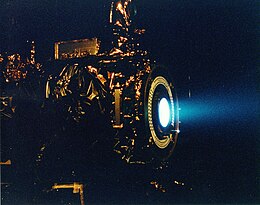
Back Ioonenjin Afrikaans محرك أيوني Arabic Propulsor iónicu AST Іонны рухавік Byelorussian Йонен двигател Bulgarian Motor iònic Catalan Iontový motor Czech Ion-motor Danish Ionenantrieb German Jonpelilo Esperanto



An ion thruster, ion drive, or ion engine is a form of electric propulsion used for spacecraft propulsion. An ion thruster creates a cloud of positive ions from a neutral gas by ionizing it to extract some electrons from its atoms. The ions are then accelerated using electricity to create thrust. Ion thrusters are categorized as either electrostatic or electromagnetic.
Electrostatic thruster ions are accelerated by the Coulomb force along the electric field direction. Temporarily stored electrons are reinjected by a neutralizer in the cloud of ions after it has passed through the electrostatic grid, so the gas becomes neutral again and can freely disperse in space without any further electrical interaction with the thruster.
By contrast, electromagnetic thruster ions are accelerated by the Lorentz force to accelerate all species (free electrons as well as positive and negative ions) in the same direction whatever their electric charge, and are specifically referred to as plasma propulsion engines, where the electric field is not in the direction of the acceleration.[1][2]
Ion thrusters in operation typically consume 1–7 kW of power, have exhaust velocities around 20–50 km/s (Isp 2000–5000 s), and possess thrusts of 25–250 mN and a propulsive efficiency 65–80%[3][4] though experimental versions have achieved 100 kW (130 hp), 5 N (1.1 lbf).[5]
The Deep Space 1 spacecraft, powered by an ion thruster, changed velocity by 4.3 km/s (2.7 mi/s) while consuming less than 74 kg (163 lb) of xenon. The Dawn spacecraft broke the record, with a velocity change of 11.5 km/s (7.1 mi/s), though it was only half as efficient, requiring 425 kg (937 lb) of xenon.[6]
Applications include control of the orientation and position of orbiting satellites (some satellites have dozens of low-power ion thrusters), use as a main propulsion engine for low-mass robotic space vehicles (such as Deep Space 1 and Dawn),[3][4] and serving as propulsion thrusters for crewed spacecraft and space stations (e.g. Tiangong).[7]
Ion thrust engines are generally practical only in the vacuum of space as the engine's minuscule thrust cannot overcome any significant air resistance without radical design changes, as may be found in the 'Atmosphere Breathing Electric Propulsion' concept. The Massachusetts Institute of Technology (MIT) has created designs that are able to fly for short distances and at low speeds at ground level, using ultra-light materials and low drag aerofoils. An ion engine cannot usually generate sufficient thrust to achieve initial liftoff from any celestial body with significant surface gravity. For these reasons, spacecraft must rely on other methods such as conventional chemical rockets or non-rocket launch technologies to reach their initial orbit.
- ^ Jahn, Robert G. (1968). Physics of Electric Propulsion (1st ed.). McGraw Hill Book Company. ISBN 978-0070322448. Reprint: Jahn, Robert G. (2006). Physics of Electric Propulsion. Dover Publications. ISBN 978-0486450407.
- ^ Jahn, Robert G.; Choueiri, Edgar Y. (2003). "Electric Propulsion" (PDF). Encyclopedia of Physical Science and Technology. Vol. 5 (3rd ed.). Academic Press. pp. 125–141. ISBN 978-0122274107. Archived (PDF) from the original on 10 October 2022.
- ^ a b "Choueiri, Edgar Y., (2009) New dawn of electric rocket The Ion Drive" (PDF). Archived (PDF) from the original on 10 October 2022.
- ^ a b Cite error: The named reference
Choueiriwas invoked but never defined (see the help page). - ^ "NASA's new ion thruster breaks records, could take humans to Mars". futurism.com.
- ^ Haldenwang, Jim. "The Human Exploration of Mars". Jim's Science Page. Retrieved 3 May 2019.
- ^ 张 (Zhang), 保淑 (Baoshu) (21 June 2021). "配置4台霍尔电推进发动机 "天宫"掀起太空动力变革 [Hall-effect thruster for Tiangong set off space drive revolution ]". 中国新闻网 (in Chinese). Archived from the original on 6 July 2021. Retrieved 18 July 2021.